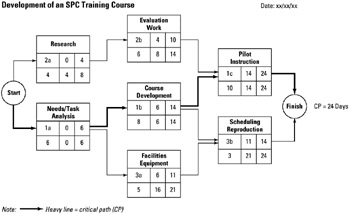Tool 7: Activity Network Diagram
| AKA | Arrow Analysis, Node Diagram |
| Classification | Planning/Presenting (PP) |
Tool description
The activity network diagram is a project planning and scheduling tool for product development or improvements. It graphically displays the sequential flow of activities, estimated time requirement and start/finish times, critical path, and interrelationship of activities.
Typical application
-
To map and schedule in a logical sequence all required activities in a project to be completed.
-
To identify a critical path and resource allocations.
-
To coordinate and control parallel activities, estimated completion times, and to meet critical data deadlines.
Problem-solving phase
| Select and define problem or opportunity | |
| Identify and analyze causes or potential change | |
| Develop and plan possible solutions or change | |
| → | Implement and evaluate solution or change |
| → | Measure and report solution or change results |
| Recognize and reward team efforts |
Typically used by
| Research/statistics | |
| Creativity/innovation | |
| 1 | Engineering |
| 3 | Project management |
| 2 | Manufacturing |
| 5 | Marketing/sales |
| 6 | Administration/documentation |
| Servicing/support | |
| Customer/quality metrics | |
| 4 | Change management |
before
-
Work breakdown structure (WBS)
-
Top-Down Flow Chart
-
Activity analysis
-
Project prioritization matrix
-
Process analysis
after
-
Responsibility matrix
-
Milestones chart
-
Gantt chart
-
Project planning log
-
Resource histogram
Notes and key points

The longest completion time from starting the first task to finishing the last task Slack (Float):

Step-by-step procedure
-
STEP 1 Complete a work breakdown structure (WBS) or similar data collection activity to identify and sequence project activities to be completed. See example Development of a Statistical Process Control (SPC) Training Course.
-
STEP 2 Sort and sequence all activities from left to right, determine parallel paths and interrelationship.
-
STEP 3 Complete, on post-its, all required information as shown in notes and Key points and this example.
-
Record name of activities, task identification, estimated completion time, and early/late start and finish times. For calculating the critical path, add all estimated times from start to finish of the project. This is also the longest completion time and the earliest time that the project can be completed. There is no slack (float) time.
-
For calculating early start/finish times, add the estimated time for each task (left-to-right) to the cumulative duration of the preceding tasks.
-
For calculating late start/finish times, subract the estmated time for each task (right-to-left) from the late start (LS) time of the succeeding task.
-
For calculating slack or float time, determine the differences (if any) between the early start (ES) and the late start (LS) for each task. Also, calculate slack in each path of the diagram as shown in the example.
-
-
STEP 4 Finalize the diagram by chaining all nodes and checking sequential and logical flow.
-
STEP 5 Check all information, title and date the chart.
Example of tool application

EAN: 2147483647
Pages: 326